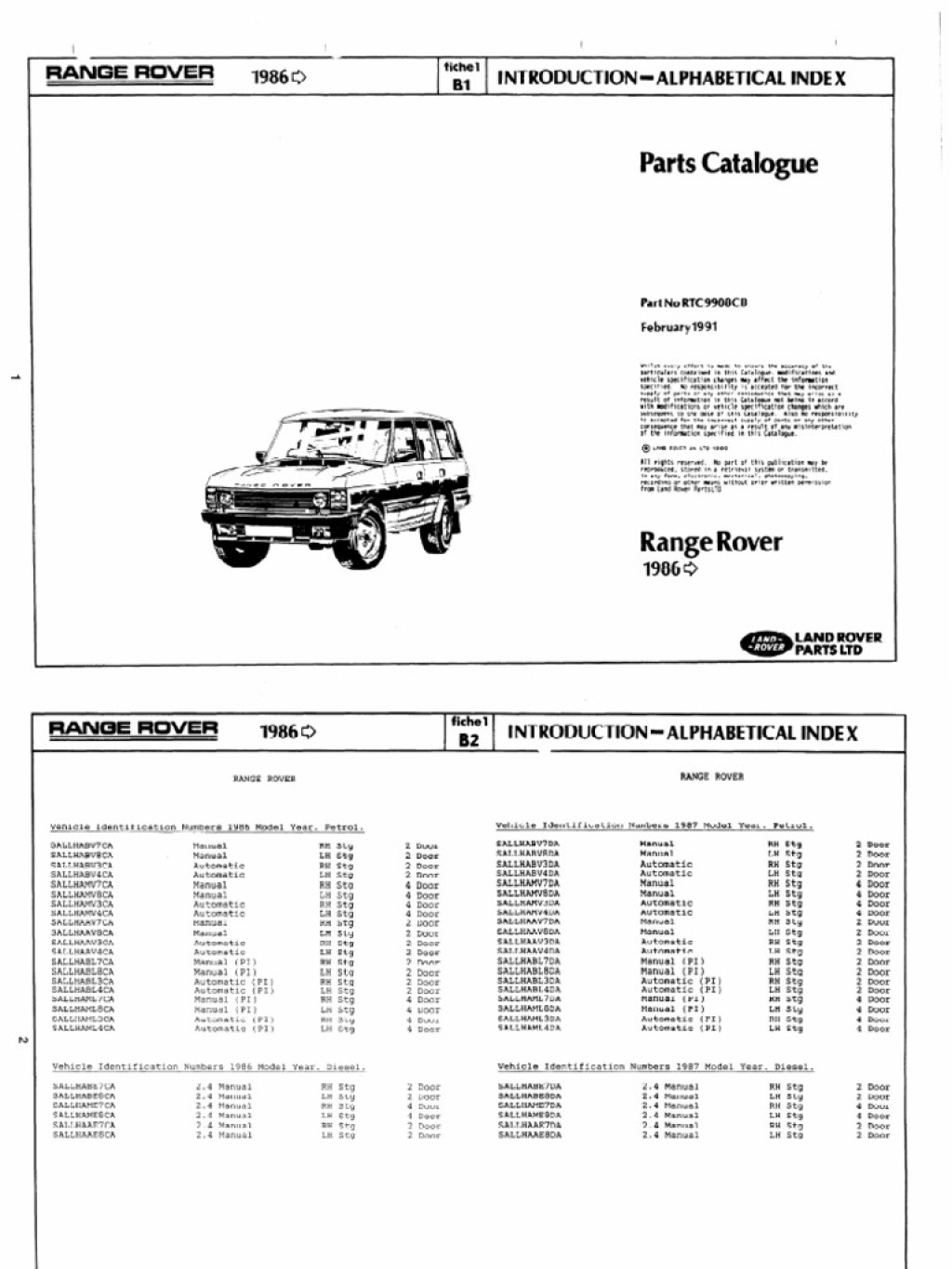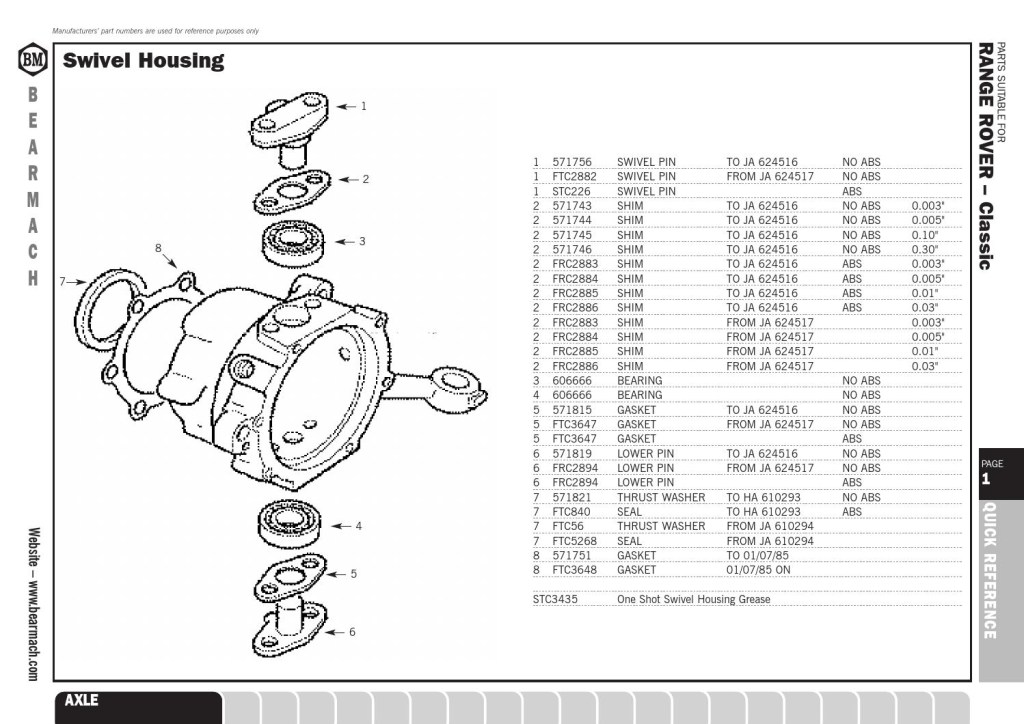The Ultimate Guide To Range Rover Classic Parts: Your Must-Have Manual For Optimal Performance
Introduction
The Range Rover Classic Parts Manual is an essential tool for any owner or enthusiast of this iconic vehicle. The manual covers all aspects of the Range Rover Classic, including its history, specifications, and maintenance procedures. This guide is an invaluable resource for anyone looking to restore or maintain their Range Rover Classic, with detailed information on every aspect of the vehicle.
Body Paragraphs
What is the Range Rover Classic Parts Manual?
The Range Rover Classic Parts Manual is a comprehensive guide to every aspect of the Range Rover Classic. It covers all the technical details of the vehicle, including its engine options, transmission types, and chassis design. The manual also includes detailed instructions for servicing and repairing the vehicle, making it an essential resource for anyone looking to maintain their Range Rover Classic.
3 Picture Gallery: The Ultimate Guide To Range Rover Classic Parts: Your Must-Have Manual For Optimal Performance



Who Needs the Range Rover Classic Parts Manual?
Anyone who owns or is interested in the Range Rover Classic should have a copy of the Parts Manual. This manual is ideal for owners who want to maintain their vehicle themselves, as well as for enthusiasts who want to learn more about the technical details of the vehicle.
When Was the Range Rover Classic Parts Manual First Published?

Image Source: scribdassets.com
The Range Rover Classic Parts Manual was first published in the 1980s, when the Range Rover Classic was still in production. The manual has been updated over the years to reflect changes in the vehicle and to provide the latest information on servicing and maintenance.
Where Can I Find the Range Rover Classic Parts Manual?
The Range Rover Classic Parts Manual can be found online or at specialist bookstores. Many Range Rover Classic enthusiasts also offer copies of the manual for sale, making it easy to find a copy.
Why is the Range Rover Classic Parts Manual Important?
The Range Rover Classic Parts Manual is important because it provides detailed information on every aspect of the vehicle. This information is essential for anyone looking to maintain or restore their Range Rover Classic, as well as for enthusiasts who want to learn more about the technical details of the vehicle.
How Do I Use the Range Rover Classic Parts Manual?

Image Source: britpart.com
The Range Rover Classic Parts Manual is designed to be easy to use, with clear instructions and diagrams. Simply find the section of the manual that relates to the part of the vehicle you need to work on, and follow the instructions provided.
Model
The Range Rover Classic was first introduced in 1970 and was produced in various models until 1996. The original model was a 2-door, but in 1981, a 4-door version was added. The Range Rover Classic was designed as a luxury SUV, with a focus on off-road capabilities.
System
The Range Rover Classic was equipped with a permanent four-wheel-drive system, which made it an excellent vehicle for off-road use. The system was designed to distribute power to the wheels with the most traction, ensuring maximum grip in all conditions.
Seating Capacity

Image Source: isu.pub
The Range Rover Classic could seat up to five passengers comfortably, with plenty of legroom and headroom. The rear seats could be folded down to create extra storage space, making the vehicle ideal for long trips or outdoor activities.
Features and Options
The Range Rover Classic was equipped with a range of luxury features, including air conditioning, power windows, and a premium sound system. Options such as leather seats and a sunroof were also available, making the vehicle even more comfortable and luxurious.
Controls and Instruments
The Range Rover Classic was fitted with a range of controls and instruments, including a digital dashboard, climate control system, and a range of buttons and switches for controlling various features of the vehicle.
Interior
The Range Rover Classic had a spacious and luxurious interior, with high-quality materials and attention to detail throughout. The seats were comfortable and supportive, and the cabin was quiet, even at high speeds.
Instructions, Service, and Repair
The Range Rover Classic Parts Manual includes detailed instructions for servicing and repairing the vehicle, making it an essential resource for anyone looking to maintain their Range Rover Classic. The manual covers everything from routine maintenance procedures to major repairs, with step-by-step instructions and diagrams.
Facilities and Accessibility
The Range Rover Classic was designed to be easy to work on, with plenty of access to the engine and other components. The vehicle was also designed with off-road use in mind, with high ground clearance and a solid chassis that could withstand rough terrain.
Technologies and Functions
The Range Rover Classic was equipped with a range of advanced technologies, including a digital dashboard, climate control system, and a premium sound system. The vehicle also had a range of off-road features, including a locking differential and a low-range transfer case.
Benefits and Specifications
The Range Rover Classic was a versatile and capable vehicle, with a range of benefits for both on-road and off-road use. The vehicle had a maximum towing capacity of 7,700 pounds and could handle steep inclines and rough terrain with ease. Specifications varied depending on the model year, but the vehicle was generally well-equipped and capable.
Capabilities and Engine Options
The Range Rover Classic was available with a range of engine options, including petrol and diesel engines. The most common engine was the 3.5-liter V8 petrol engine, which was capable of producing up to 175 horsepower.
Transmission Types and Chassis Design
The Range Rover Classic was equipped with a four-speed automatic transmission, which provided smooth and efficient shifting. The vehicle was also designed with a solid chassis that could withstand rough terrain and off-road use.
Dimensions and Safety
The Range Rover Classic was a large and spacious vehicle, with a length of over 180 inches and a width of over 70 inches. The vehicle was also equipped with a range of safety features, including anti-lock brakes, airbags, and traction control.
Available Trims
The Range Rover Classic was available in a range of trims, including the SE, HSE, and County. Each trim level offered different features and options, with the HSE being the most luxurious and well-equipped.
Pros and Cons
Pros:
– The Range Rover Classic is a versatile and capable vehicle, with excellent off-road capabilities.
– The vehicle is spacious and comfortable, with high-quality materials and attention to detail throughout.
– The Range Rover Classic is a classic and iconic vehicle, with a rich history and a loyal following.
Cons:
– The Range Rover Classic can be expensive to maintain and repair, especially if parts are difficult to find.
– The vehicle can be heavy and cumbersome to drive, especially in urban environments.
– The Range Rover Classic is not particularly fuel-efficient, with low gas mileage and high emissions.
Conclusion
The Range Rover Classic Parts Manual is an essential resource for anyone looking to maintain or restore their Range Rover Classic. With detailed instructions and diagrams for every aspect of the vehicle, this manual is an invaluable tool for owners and enthusiasts alike. Whether you’re looking to service the engine or repair the suspension, the Range Rover Classic Parts Manual has everything you need to keep your vehicle running smoothly. So if you own a Range Rover Classic or are simply interested in this iconic vehicle, be sure to get a copy of the Parts Manual today!
This post topic: Manual


